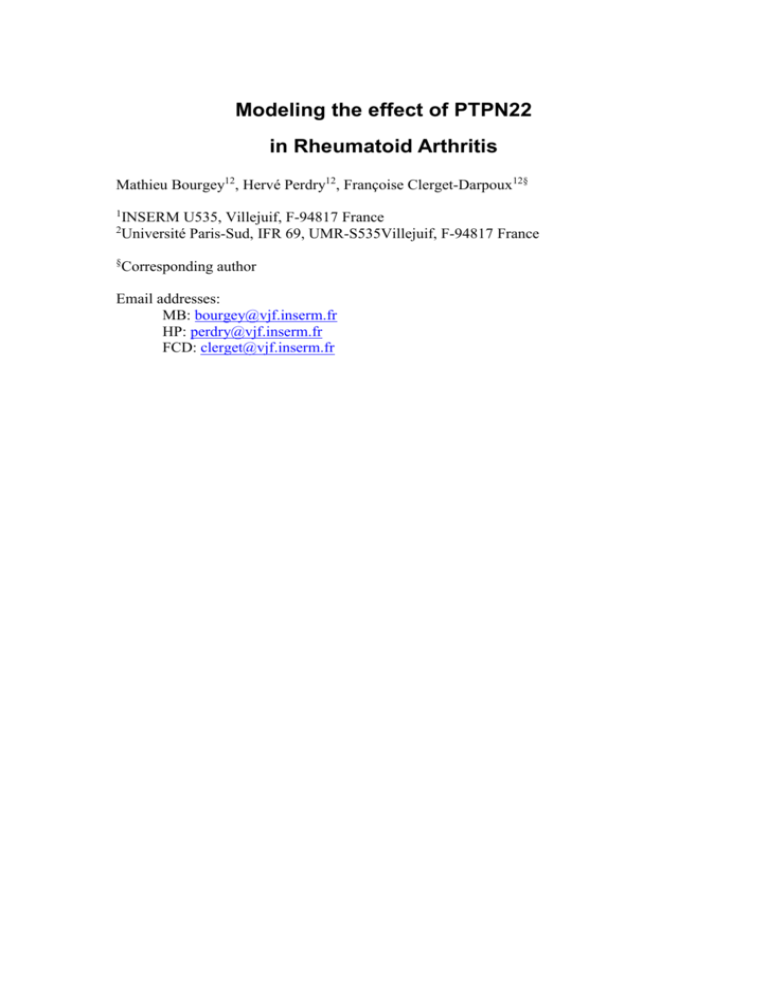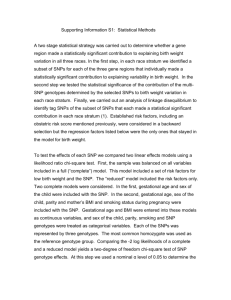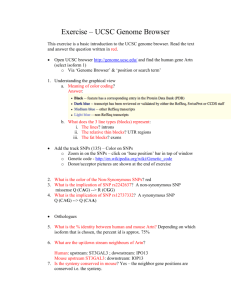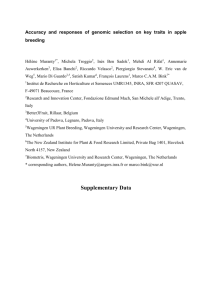Modeling the effect of PTPN22 - HAL
advertisement

Modeling the effect of PTPN22 in Rheumatoid Arthritis Mathieu Bourgey12, Hervé Perdry12, Françoise Clerget-Darpoux12§ 1 2 INSERM U535, Villejuif, F-94817 France Université Paris-Sud, IFR 69, UMR-S535Villejuif, F-94817 France § Corresponding author Email addresses: MB: bourgey@vjf.inserm.fr HP: perdry@vjf.inserm.fr FCD: clerget@vjf.inserm.fr Abstract In order to model the effect of PTPN22 in Rheumatoid Arthritis (RA), we determined the combination of Single Nucleotide Polymorphisms (SNPs) showing the strongest association with RA. Three SNPs (rs2476601-rs12730735-rs11102685) were selected for which we estimated the Genotypic Relative Risks (GRRs) of the corresponding genotypes. Based on these GRRs we defined four at-risk genotypic classes. Relative to the class of reference risk, individuals had a risk approximately multiplied by 2, 3 or 4. This classification was confirmed by the excess of Identity By Descent (IBD) sharing (IBD = 2) for the sibs of an index in the high risk class and by excess of non-IBD sharing (IBD = 0) when the index belonged to the low risk class. The observed data could not be explained by the role of a single variant but were compatible either with a joint effect of the 3 typed SNPs of PTPN22 in RA or with the role of two untyped variants. Background The SNP R620W, also denoted rs2476601, is located within the hematopoietic-specific protein tyrosine phosphatase gene, PTPN22. This SNP (C/T) codes for an amino acid change and the frequency of its minor allele T has been recently and repeatedly shown to be increased in patients with rheumatoid arthritis (RA) [1-3]. The allele T confers 1.7-1.9 fold increased risk to heterozygote and higher risks to homozygote carriers[4] compared to the non carrier individuals. This variant is also well known to be associated with several other auto-immune diseases[2], such as the systemic lupus erythematosus and the type 1 diabetes. Recently, Carlton et al.[4] studied the PTPN22 genetic variations in the North American Rheumatoid Arthritis Consortium (NARAC) data. Using the information on several SNPs typed in PTPN22, they compared the haplotype distributions in NARAC patients and controls. They demonstrated that SNP R620W does not fully explain the association between PTPN22 and RA and suggested the effect of at least one additional variant in the PTPN22 gene. We propose here to reanalyze the NARAC data using both association and linkage information for modeling the role of PTPN22 in RA. Data and Methods Data We selected from the NARAC data the 511 families with affected sib pairs typed for 14 SNPs of PTPN22, and 1404 unrelated controls also typed for all these SNPs. For each affected sib pair we considered the proband as an index RA patient. The R620W SNP is one of the 14 SNPs in PTPN22. It is located at the ninth position, so it will be subsequently denoted as SNP 9. A preliminary study of Linkage Disequilibrium (LD) among the 14 SNPs was examined in the 1404 controls. The LD analysis lead us to exclude 3 SNPs (SNP 2, SNP 12, SNP 13), which are in complete linkage disequilibrium with one (or more) other SNP(s). Selection of associated SNPs The Combination Test [5] was used on the 11 remaining SNPs to select the subset of SNPs showing a significant difference in the genotypic distribution between RA index patients and controls. Its principle consists in testing all possible combinations of SNPs within a gene. Here, there are (211 - 1) possible combinations. Such a systematic testing of all SNPs and all SNP combinations raises the problem of multiple and nonindependent tests. This problem is generally solved by the implementation of a permutation procedure that allows estimation of corrected p-values. Here, associated combinations are very significant and the number of permutations necessary to discriminate them would be extremely high and almost unreachable. Nevertheless, the chi-square values of the genotypic association test are so high that even the conservative Bonferroni correction can be used. We selected the most associated and parsimonious subset of SNPs by Nested Chi-Square Tests (NCST) in a forward procedure. The NCST compares the strength of association between nested significant subsets. Genotypic relative risk estimation For the selected subset of SNPs, we computed with the Marker Association Segregation Chi-square (MASC) method [6] the genotypic relative risk (GRR) of each genotype using the genotype distributions of index and controls conditionally on the fact that the index has an affected sib. Stratified sib pair IBD estimation Conditionally on each marker genotype of the index cases, the number of IBD parental alleles shared by the index case and one affected sib were estimated on PTPN22 with the MERLIN software [7]. MERLIN is able to take into account LD between SNPs during the IBD computation. So the estimated IBD distributions are computed on the overall set of SNPs even if they are in LD. The fit of a model to the IBD distributions stratified on index marker genotypes [8] may then be tested by the MASC method. Modeling PTPN22 effect Finally, we applied the MASC method [6] to find the most parsimonious model explaining the overall observations, i.e. the genotype and the stratified sib pair IBD distributions. To do this, MASC requires the haplotype frequencies in the general population, which were estimated on the unrelated controls by the MERLIN software. The MASC method computes for a given genetic model the expected genotype marker distribution and the expected sib pair IBD distributions stratified on marker genotypes. Here, the computation of the genotypic distribution is conditioned on the fact that index cases have an affected sib. The global expected likelihood of the genetic model given the observed data is then computed as the product of the likelihoods of each expected distribution, and is maximized on the model parameters. The fit of the model to the observed data is tested by a likelihood ratio test (LRT) between global expected likelihood and the likelihood of the saturated model. Results Selection of associated SNPs Many subsets of SNPs show significant associations. Table 1Table 1 presents a selection of the most associated combinations of one, two and three SNPs. When considering only the effect of a single SNP, the only significant associated one after correction for multiple testing is SNP 9. The combination of SNPs 9-10 is the one which, among the combination of two SNPs, improves the association shown by the SNP 9 alone (p = 0.017) the best. The subset SNPs 9-10-11 (rs2476601-rs12730735rs11102685) is the only one that improves significantly the association shown by the SNPs 9-10 (p = 0.038). Adding another SNP to this subset does not significantly improve the association. Consequently, all the subsequent analyses have been done considering SNPs 9-10-11 and their ten corresponding genotypes. GRR estimation Table 2Table 2 displays the genotypes and the corresponding GRRs for SNP 9 taken alone (columns 1 and 2) and for the set of the three SNPs 9-10-11 (columns 3 and 4). The GRRs vary from 1 to 2.7 when considering only SNP 9, whereas the variation ranges from 1 to 4.7 when the information on the three SNPs is taken into account. Interestingly, the CC genotype of the SNP 9 can be sub-divided in several genotypes when taking into account the genotypes for SNPs 10 and 11 (rows 1 to 6) with GRRs ranging from 1 (CC-GG-AA) to 3.6 (CC-AA-GG). This observation demonstrates the importance of using the additional information on SNPs 10-11. Sib pair IBD estimation The proportion of RA sibs sharing 0, 1 or 2 parental alleles for PTPN22 is 0.26 (181 pairs), 0.51 (362 pairs), and 0.23 (167 pairs) respectively and does not differ from the IBD distribution 0.25; 0.5; 0.25 expected under no linkage. However, if our GRRs correctly reflect the differential risk of RA, we expect to see differences in the IBD vectors stratified on the genotypes of the subset of SNPs 9-10-11[8]. To avoid cells with small numbers of individuals we pooled sib pairs with the index genotypes (SNP 9-10-11) which have similar risk. We thus defined 4 arbitrary at risk genotypic classes: the low risk class (L; GRR = 1; 19 pairs), the intermediate risk class 1 (I1; 1 < GRR ≤ 2; 295 pairs), the intermediate risk class 2 (I2; 2 < GRR ≤ 3; 157 pairs) and the high risk class (H; GRR > 3; 34 pairs). Table 3Table 3 shows that the proportion of IBD = 0 decreases from 0.47 to 0.09 according to the fact that the index belongs to class L or class H and conversely the proportion of IBD = 2 increases from 0.11 to 0.26. These stratified IBD distributions are consistent with the risk genotypic classes. In contrast, the IBD sharing distributions stratified only on SNP 9 genotypes are not consistent with the GRR estimates on this SNP (Table 4). Modeling PTPN22 effect We apply the MASC method in using the genotype distribution only on the SNP 9 and the IBD stratified on the SNP 9 genotypes. In that case, the single and causal effect of the SNP 9 is not rejected (p = 0.29). Then, we model the effect of PTPN22 using the 4 genotypic groups of risk defined on the genotypes of the combination of the SNPs 9-10-11 and the IBD information stratified on them. In this case, we reject the direct effect of SNP 9 (p = 0.005). We also reject the effect of a single untyped SNP (p = 0.04). However we do not reject the interactive effect of the 3 SNPs (p = 0.53) or the interactive effect of 2 untyped SNPs. Discussion The involvement of PTPN22 and HLA in RA susceptibility is no longer disputed. However, as shown by Carlton et al. and confirmed in this study, the role of PTPN22 cannot be explained only by the R620W SNP. A correct modeling of PTPN22 is important and shows that the genotypic risk varies much more (1 to 4.7) than reported in the literature (1 to 2.7)[4]. In this study we proposed, for the first time, a model for the effect of PTPN22, taking into account both association and linkage information. Another method, called LAMP[9] was recently proposed for joint modeling of linkage and association [9]. The linkage information used by the LAMP method is the global IBD sharing of affected sib pairs. However, it is very important to note that the power of model discrimination strongly depends on the association and linkage information that is used. As shown here, the information on SNP 9 alone and on the global IBD is very poor as compared to that of the 3 SNPs 9-10-11 and to the stratified IBD distributions on the 4 at risk genotype groups. In conclusion, we applied a 4 step strategy to model the effect of a candidate gene covered by several SNPs: (1) to select the most associated set of SNPs; (2) to group the corresponding genotypes according their GRRs; (3) to stratify IBD sharing information on the at-risk genotype groups; (4) to model the effect of the candidate gene while taking into account both linkage and association information. This strategy allowed better modeling of the effect of PTPN22 in RA susceptibility. Recently, Tezenas du Montcel et al.[10] refined the modeling of HLA in RA susceptibility. A next step will be to use simultaneously the PTPN22 and HLA information to evaluate their joint effects while taking into account important covariables such as age and gender. Acknowledgements MB was supported by a grant from FRM (Fondation pour la Recherche Médicale).HP was supported by a grant from ARSEP (Association pour la Recherche sur la Sclérose en Plaques). References 1. 2. 3. 4. Hinks A, Barton A, John S, Bruce I, Hawkins C, Griffiths CE, Donn R, Thomson W, Silman A, Worthington J: Association between the PTPN22 gene and rheumatoid arthritis and juvenile idiopathic arthritis in a UK population: further support that PTPN22 is an autoimmunity gene. Arthritis and rheumatism 2005, 52(6):1694-1699. Criswell LA, Pfeiffer KA, Lum RF, Gonzales B, Novitzke J, Kern M, Moser KL, Begovich AB, Carlton VE, Li W et al: Analysis of families in the multiple autoimmune disease genetics consortium (MADGC) collection: the PTPN22 620W allele associates with multiple autoimmune phenotypes. American journal of human genetics 2005, 76(4):561-571. Begovich AB, Carlton VE, Honigberg LA, Schrodi SJ, Chokkalingam AP, Alexander HC, Ardlie KG, Huang Q, Smith AM, Spoerke JM et al: A missense single-nucleotide polymorphism in a gene encoding a protein tyrosine phosphatase (PTPN22) is associated with rheumatoid arthritis. American journal of human genetics 2004, 75(2):330-337. Carlton VE, Hu X, Chokkalingam AP, Schrodi SJ, Brandon R, Alexander HC, Chang M, Catanese JJ, Leong DU, Ardlie KG et al: PTPN22 genetic variation: evidence for multiple variants associated with rheumatoid arthritis. American journal of human genetics 2005, 77(4):567-581. 5. 6. 7. 8. 9. 10. Jannot AS, Essioux L, Reese MG, Clerget-Darpoux F: Improved use of SNP information to detect the role of genes. Genetic epidemiology 2003, 25(2):158-167. Clerget-Darpoux F, Babron MC, Prum B, Lathrop GM, Deschamps I, Hors J: A new method to test genetic models in HLA associated diseases: the MASC method. Annals of human genetics 1988, 52(Pt 3):247-258. Abecasis GR, Cherny SS, Cookson WO, Cardon LR: Merlin--rapid analysis of dense genetic maps using sparse gene flow trees. Nature genetics 2002, 30(1):97-101. Clerget-Darpoux F, Babron MC, Bickeboller H: Comparing the power of linkage detection by the transmission disequilibrium test and the identityby-descent test. Genetic epidemiology 1995, 12(6):583-588. Li M, Boehnke M, Abecasis GR: Joint modeling of linkage and association: identifying SNPs responsible for a linkage signal. American journal of human genetics 2005, 76(6):934-949. du Montcel ST, Michou L, Petit-Teixeira E, Osorio J, Lemaire I, Lasbleiz S, Pierlot C, Quillet P, Bardin T, Prum B et al: New classification of HLADRB1 alleles supports the shared epitope hypothesis of rheumatoid arthritis susceptibility. Arthritis and rheumatism 2005, 52(4):1063-1068. Tables Table 1 - Most associated subsets of one, two and three SNPs The first column lists the name of the SNP combinations for which columns 2, 3 and 4 give the degrees of freedom (df), the chi-square value and the corrected p-value (Bonferroni correction) of the association test respectively. Column 5 gives the nested combinations which are compared by the NCST. Lastly, columns 6, 7 and 8 give the df, the value and the pvalue of the NCST respectively. 9 Χ² df 2 Χ² value 47.6 Corrected p value 9.5e-8 Compared subsets - 4_9 9_10 4 7 54.0 61.3 11.0e-8 17.2e-8 4_9 vs. 9 9_10 vs. 9 2 5 6.4 13.7 0.041 0.017 9_11 9_10_11 5 12 57.3 73.0 9.2e-8 17.8e-8 9_11 vs. 9 9_10_11 vs. 9_10 3 5 9.7 11.7 0.021 0.038 Subset NCST NCST df value - NCST p-value - Table 2 - GRR estimates Genotypes and corresponding estimates of GRR for the SNP 9 (columns 1 and 2) and for the combination of SNPs 9-10-11 (columns 3 and 4). SNP 9 GRR SNP 9-10-11 CC-AA-AA CC-AA-AG CC 1 CC-AA-GG CC-AG-AA CC-*G-AG CC-GG-AA CT-AA-AA CT 1.66 CT-AA-AG CT-AG-AA TT-A*-AA TT 2.7 * Either the A or the G alleles of the SNP 10. GRR 1.60 1.76 3.60 1.73 2.35 1 2.88 3.11 2.61 4.68 Table 3 - IBD distribution for the four risk classes L, I1, I2 and H IBD distributions stratified on the index classes are given in proportions and in effectives. Classes L I1 I2 H IBD = 0 0.47(9) 0.29 (85) 0.26 (41) 0.09 (3) IBD = 1 0.42 (8) 0.49 (146) 0.50 (78) 0.65 (22) IBD = 2 0.11 (2) 0.22 (64) 0.24 (38) 0.26 (9) Table 4 - IBD distribution for the three genotypes of the SNP 9 IBD distributions stratified on the index genotypes are given in proportions and in effectives. Genotype of index CC CT TT IBD = 0 IBD = 1 IBD = 2 0.27 (96) 0.25 (35) 0.14 (2) 0.49 (177) 0.53 (75) 0.65 (10) 0.24 (85) 0.22 (31) 0.21 (3)




